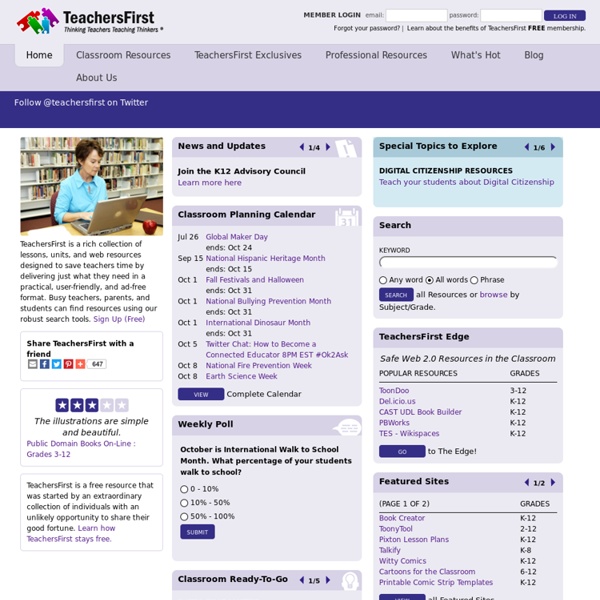



https://teachersfirst.com/index.php
Related: Pedagogy Resources • Educational Resources for teachersWhat is Passive Learning? Passive learning doesn’t have a wide variety of examples, in spite of how common it is in education. If passive learning is viewed as a teaching strategy in an educational setting, from beginning to end, it might look like these situations. An educator verbalizes information to students and checks if they know it at a later date, without providing additional learning experiences specific to that information.Students complete a reading assignment and are under formal or informal expectations to understand what they read.An educator verbalizes instructions to students and expects them to follow the instructions exactly.Students complete a lab by following step-by-step instructions and must write a report to show their understanding of the lab concepts.Students watch a video and are given a quiz immediately after.An educator works through example problems on the board and then gives students a graded assignment to complete similar problems.
PBS NewsHour Extra Extra News for Students and Teacher Resources 7–12 Grade Level Lesson Plans Results on ReadWriteThink Find content from Thinkfinity Partners using a visual bookmarking and sharing tool. More Your students can save their work with Student Interactives. Podcasts In English ► Level 1 For elementary and pre-intermediate students ► Level 2 For intermediate students Printable Lesson Plan Book Pages & Homework Assignment Sheets STW Filing Cabinet Logged in members can use the Super Teacher Worksheets filing cabinet to save their favorite worksheets. Quickly access your most commonly used files AND your custom generated worksheets! Please login to your account or become a member today to utilize this helpful new feature. :) [x] close This document has been saved in your Super Teacher Worksheets filing cabinet. Here you can quickly access all of your favorite worksheets and custom generated files in one place!
A List of Brain-based Strategies to Create Effective eLearning There is a simple way to design effective eLearning courses about any subject: brain-based learning. This instructional approach was defined by Hileman in 2006 and has since inspired many “brain compatible designers” — those who seek to understand the principle and reasoning behind their teaching. The idea behind the concept is that learning is innate and linked to biological and chemical processes in the human brain. Open Professionals Education Network CC licensed (BY) Flickr photo shared by David Amsler modified by Paul Stacey Reusing existing Open Educational Resources (OER) can save significant time and effort. The OPEN partners recommend TAACCCT grantees invest up-front time finding OER to reuse rather than starting development of new educational resources right away. A significant benefit of OER is that they provide source material to build your development efforts around. No need to invest development effort in creating something that already exists. OER come in a wide variety of types.
Digital Play In the University of Bristol’s Education Endowment Foundation‘s recent study on Neuroscience and Education, (Howard-Jones, 2014), there is an interesting section on Learning Games. Classroom practice and neuroscientific research The review ”considers the extent to which insights from the sciences of mind and brain influence, or are close to influencing classroom practice”, summarising “existing evidence about approaches and interventions that are based, or claim to be based, on neuroscience evidence.” The report categorises the approaches into 1) those which are likely to have a positive impact on attainment, 2) those which need further testing to determine the likely impact on attainment, and 3) those which do not seem to have a promising impact on attainment.
How to Use Google Search More Effectively [INFOGRAPHIC] Among certain circles (my family, some of my coworkers, etc.) I'm known for my Googling skills. I can find anything, anywhere, in no time flat. 18 Alternatives to Essays As a history teacher, I've always struggled with the idea of giving students essays. My struggle isn't with essays themselves. Essays can convey amazing amounts of information, persuade an audience to your side, or analyze topics in depth. Intelligent YouTube Channels Below, we have gathered together some of the most intelligent video collections on YouTube. A great place to find culturally enriching video... General Universities Spotlighted Collections YouTube EDUYouTube got a lot more intelligent when it launched YouTube EDU, a section of the site that centralizes all of its educational/academic content.
ICT Lesson Repository About us Courses & workshops Consultancy services Clients & publications What Do Emotions Have to Do with Learning? Thinkstock When parents and teachers consider how children learn, it’s usually the intellectual aspects of the activity they have in mind. Sidney D’Mello would like to change that. The University of Notre Dame psychologist has been studying the role of feelings in learning for close to a decade, and he has concluded that complex learning is almost inevitably “an emotionally charged experience,” as he wrote in a paper published in the journal Learning and Instruction earlier this year. During the learning experiments described in his paper, he notes, the participating students reported being in a neutral state only about a quarter of the time. The rest of the time, they were were experiencing lots of feelings: surprise, delight, engagement, confusion, boredom, frustration.
A model for the learning process. And why it helps to have one. One of the most powerful ideas I’ve engaged with recently is using a diagram to visualise a shared model of the learning process; using it to get a feel for how learning works in general but also to identify reasons for why it can sometimes not happen. This is the diagram I have in my Rosenshine Principles book, courtesy of Oliver Caviglioli: I’ve found it massively helpful as a focus during CPD as we’ve explored a range of interlocking, overlapping ideas: